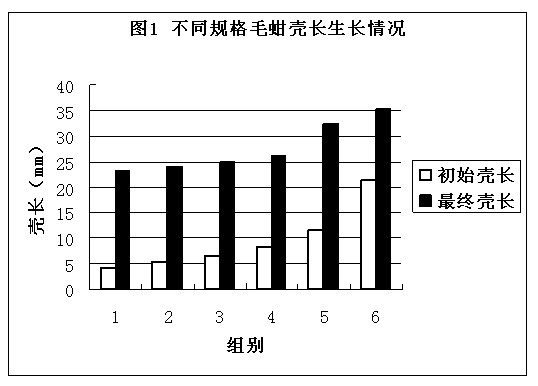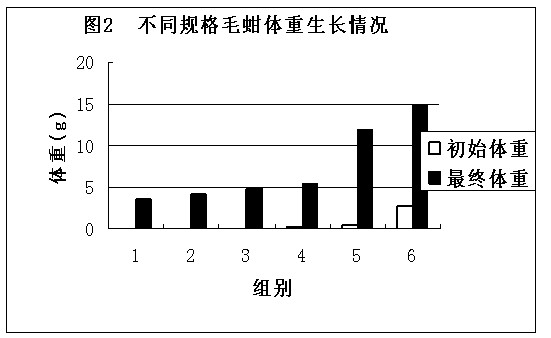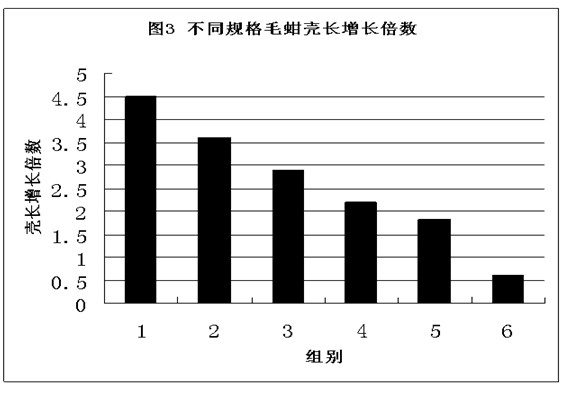Ecological cultivation method of arca subcrenata lischke
A technology of ecological breeding and breeding method, applied in the field of ecological breeding of clams, can solve the problems of the influence of growth amount and survival rate, the great influence of clams breeding, etc., and achieve the effects of ensuring the quality of aquatic products, improving economic benefits, and purifying water quality.
- Summary
- Abstract
- Description
- Claims
- Application Information
AI Technical Summary
Problems solved by technology
Method used
Image
Examples
Embodiment 1
[0021] Effects of different specifications of cockles on growth: At the beginning of April, the bottom soil of pond cockles was plowed, exposed to the sun for 8 days, smoothed with water, and disinfected at a rate of 1.5 kg / 667m 2 Sprinkle bio-fertilizer and water at a certain ratio to fertilize water, fertilize single-celled algae in the water, and control the density of single-celled algae in the clam field to more than 10,000 to 12,000 c / ml. Set up 6 areas in the clam field, each with an area of 20m×10m, and divide the cockle seedlings into six areas according to the six specifications of 4.2mm, 5.2mm, 6.4mm, 8.2mm, 11.6mm and 21.4mm. Density: 500 grains / m 2 . The implementation of manual even broadcasting for breeding. In the middle and late April, stocking 0.9cm long Penaeus japonicus seedlings, the input amount is 7,000 tails / 667m 2 . In June, the barracuda seedlings were put into use, and the input amount was 200-350 fish / 667m 2 ;Put in adult white shrimp or seed...
Embodiment 2
[0034] Selecting 2.67hm of cockle ecological breeding ponds in the Yellow River Delta 2 , of which the cockle field area is 4000m 2In mid-March, plow the cockle field, expose it to the sea for 10 days, and smooth it out with seawater. The seawater is filtered through a 60-mesh silk screen to remove predators. You can sprinkle tea cakes in the deep water of the pond to kill harmful fish such as shrimp and fish. . In the first ten days of April, every 1.5 kg / 667m 2 Apply biological fertilizer and water. On April 18th, the cockles were stocked, the stocking size was 21.4mm, and the stocking amount of cockles was controlled to be 500 grains / m 2 . On April 26, stocking of Penaeus japonicus fry, the stocking volume is about 10,000 tails / 667m 2 , when the length of Penaeus japonicus reaches about 5cm, start feeding Artemia adults, and feed about 125kg per day, when the length of Penaeus japonicus grows to about 8.3cm, start feeding smooth blue clams, and start fishing for Penaeu...
Embodiment 3
[0051] Water quality biological control technology, including the following steps:
[0052] a) Purification effect of bait algae on water quality: select 3 algae species of Chaetoceros mouvii, Flatweed, and Dunaliella for cultivation and expansion, take samples every 2 days, and measure pH, salinity, and COD Mn , total nitrogen, total phosphorus, algae density;
[0053] b) Effect of shrimp and shellfish ecological cultivation on water purification: the cultivation process is the same as in Example 1, and the detection and analysis indicators are the same as c;
[0054] c) The effect of bio-improvement agents on water quality purification: In 4 Erlenmeyer flasks, add bio-aeration granules, 5ppm, and 10ppm of high-efficiency biological agents, respectively, add 50ml of Chaetoceros moubii algae liquid, take the supernatant regularly, and measure PH, COD, BOD5, nitrite nitrogen, total nitrogen, total phosphorus content;
[0055] d) According to the above test results, use high-e...
PUM
 Login to View More
Login to View More Abstract
Description
Claims
Application Information
 Login to View More
Login to View More - R&D
- Intellectual Property
- Life Sciences
- Materials
- Tech Scout
- Unparalleled Data Quality
- Higher Quality Content
- 60% Fewer Hallucinations
Browse by: Latest US Patents, China's latest patents, Technical Efficacy Thesaurus, Application Domain, Technology Topic, Popular Technical Reports.
© 2025 PatSnap. All rights reserved.Legal|Privacy policy|Modern Slavery Act Transparency Statement|Sitemap|About US| Contact US: help@patsnap.com



